As a part of my Humanities journey, I found myself combing through the virtual galleries of a number of museums, searching for a piece of art that piqued my curiosity. My search ended in The British Library with the picture of a bronze and gold statue of Tara, Goddess of Mercy and Compassion.
 |
| Figure of the goddess Tara found in The British Museum |
While the artist is unknown, the statue was found on the east coast of Sri Lanka and dates back to 700-750 CE. At 143 centimeters (4 feet, 7 inches) the statue is nearly life-size and is cast in one piece of solid bronze and gilded in gold. It's also believed that the eyes and hair were once inlaid with gems.
This piece struck me since I had never heard of the goddess Tara (who appears in the Buddhism and Hinduism) and I haven't spent much time learning about female bodhisattvas, which some believe Tara to be. So, I decided to do some research about this piece to understand what the piece represents, how it reflects the time/location in which it was made, why it was made, and for whom.
There is some controversy around the figure of Tara. Some scholars like to point out that Buddhism does not worship gods, so referring to Tara as a Buddhist goddess is inaccurate. References are also made to Tara possibly being a female bodhisattva but there are also scholars who believe that Buddhist bodhisattvas are all male. No matter how you label Tara, she is clearly a supernatural figure of reverence in 6th-8th century Sri Lanka. "Tara follows a tradition of strong female role models, beginning in the ancient Vedic period (second millennium BCE), and sustained through early Mahayana times (0-400 CE). Many of these goddesses were and still are worshipped for protection from danger. Others are revered as the embodiment of wisdom." (Landesman pg. 45) I think the reverence held for the goddess is clear based on the care and craftsmanship that went into this statue.
 |
| 8th century CE Sri Lankan Bronze Statue of Unconfirmed Bodhisattva, held at the Metropolitan Museum of Art |
The figure above is considered to be Avalokiteshvara, a bodhisattva and Tara's male counterpart. Like the statue of Tara, this figure is made of bronze, but with a high amount of tin. This figure shows a sarong-like wrap around the hips and the hands in an ornate, meaningful position like the statue of Tara. Many of these aspects are common in Sri Lankan sculpture from the 6th-8th centuries. Despite these commonalities, the figure of Tara is exceptional in that it was gilded in gold and it stands unusually tall compared to typical Sri Lankan sculpture. "All the other Buddhist images of this period are half a meter at the most, here (Tara figure) we have one that is practically life size (at 1.45 meters). So far as we know she is unique." (Masterpieces, 3:23 - 3:43)
 |
| Bodhisattva from the Pala period, 12th century CE. This figure has its right hand extended in the varadamudra of giving. |
The statue of Tara must have been made by a skilled craftsman with significant care, given the materials used. It seems likely that the statue was originally housed in a temple and was meant to inspire devotees. The statue "depicts the goddess with her right hand held in a gesture known as varadamudra - the gesture of granting a wish, or offering blessings." (Daniel) This hand positioning makes me believe that this statue would have been sought out by Buddhists, in the hopes of receiving a boon from Tara.
While Tara is no longer worshipped in Sri Lanka, she is still venerated in countries like Nepal, Tibet, and Mongolia. The figure of Tara is a beautiful piece of art that carries with it the legacy of Buddhism in Sri Lanka and serves as an example of strong feminine energy in religion, dating back thousands of years.
 |
| Goddess Tara, late 9th century sculpture from Indonesia, Central Java. Held in the Los Angeles County Museum of Art |
My experience in visiting museums virtually was enlightening. I believed that virtual museums would feature a video that would give someone the same feel of "walking" the museum. Instead, many of the websites consisted of photo galleries with snippets of information about the pieces shown. I think there are opportunities to improve these websites to give viewers a better overall experience that replicates the exploration felt during in-person museum visits. I also believe that providing links to learn more about the museum pieces would be a nice touch for viewers who may find a piece inspiring. Fortunately, I found a piece that motivated me to learn more through research. My investigation included searches on Tara and her role in Buddhism, the standard of art in 6th-8th century Sri Lanka, and even the significance of Tara's hand positioning in the statue. Overall, I found this exercise in museum viewing and historical research highly enjoyable. I recommend everyone consider walking through a museum (in-person or virtually) and finding at least one piece to learn more about.
Masterpieces of the East. "The Tara Statue - Sri Lanka." YouTube, 24 Jan. 2019, https://www.youtube.com/watch?v=DGPT4ttPirk . Accessed 03 Dec. 2021.
Daniel, Shannine. "Tara: The Sri Lankan Deity At The British Museum." eLanka, 22 Aug. 2021, Tara: The Sri Lankan Deity At The British Museum- by Shannine Daniel (elanka.com.au) Accessed 03 Dec. 2021.
Landesman, Susan S. "Goddess Tara: Silence and Secrecy on the Path to Enlightenment." Journal of Feminist Studies in Religion, vol. 24, no. 1, [Indiana University Press, FSR, Inc], 2008, pp. 44-59, http://jstor.org/stable/20487912.
Comments
Post a Comment